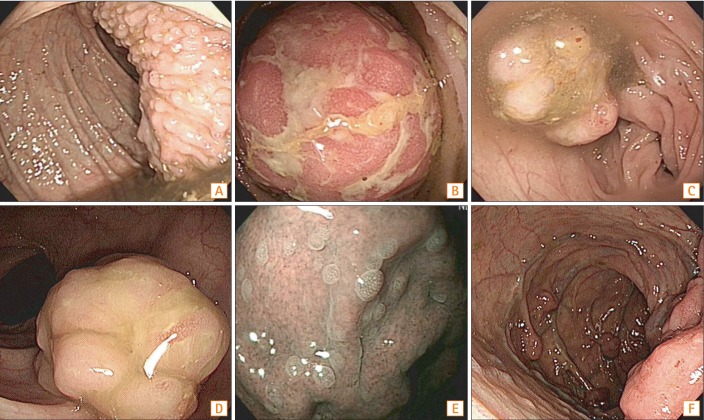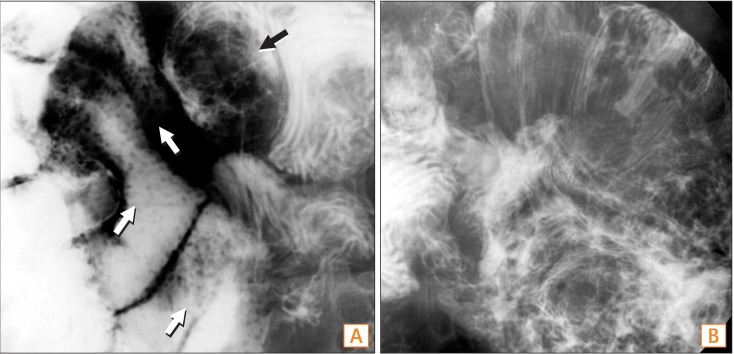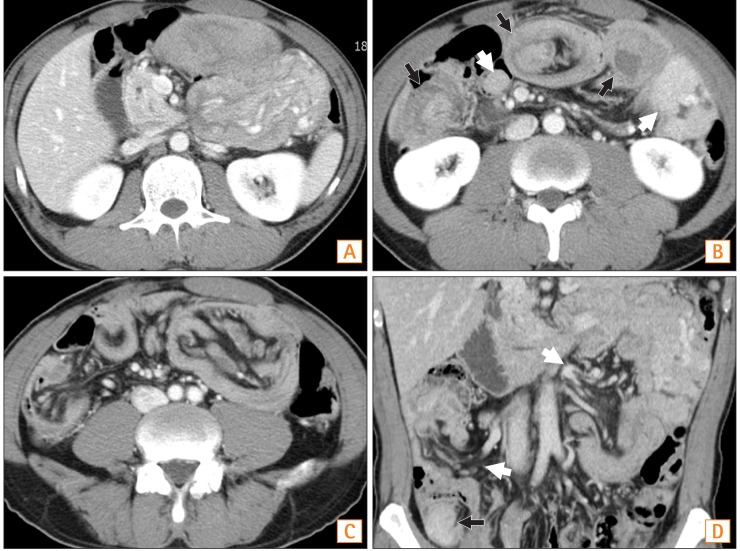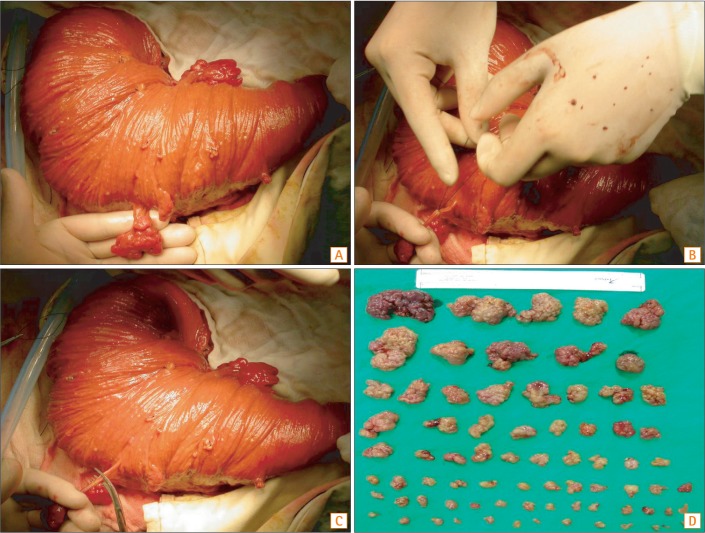Intest Res.
2014 Oct;12(4):320-327. 10.5217/ir.2014.12.4.320.
Polyp Clearance via Operative and Endoscopic Polypectomy in Patients With Peutz-Jeghers Syndrome After Multiple Small Bowel Resections
- Affiliations
-
- 1Department of Internal Medicine, Dankook University Hospital, Dankook University College of Medicine, Cheonan, Korea. emedicals@hanmail.net
- 2Department of Surgery, Dankook University Hospital, Dankook University College of Medicine, Cheonan, Korea.
- 3Department of Pathology, Dankook University Hospital, Dankook University College of Medicine, Cheonan, Korea.
- KMID: 2174410
- DOI: http://doi.org/10.5217/ir.2014.12.4.320
Abstract
- Peutz-Jeghers syndrome is an autosomal dominant inherited disease that manifests as a combination of mucocutaneous pigmentation and gastrointestinal hamartomatous polyps that usually cause intussusception and intestinal hemorrhage. We report the case of a 40-year-old male patient who was diagnosed 20 years ago and had previously undergone 3 intestinal resection surgeries. This time, with the use of combined operative and endoscopic polypectomy, more than 100 polyps were removed. This technique is useful for providing a "clean" small intestine that allows the patient a long interval between laparotomies and reduces the complications associated with multiple laparotomies and resections.
MeSH Terms
Figure
Reference
-
1. Beggs AD, Latchford AR, Vasen HF, et al. Peutz-Jeghers syndrome: a systematic review and recommendations for management. Gut. 2010; 59:975–986. PMID: 20581245.
Article2. Jenne DE, Reimann H, Nezu J, et al. Peutz-Jeghers syndrome is caused by mutations in a novel serine threonine kinase. Nat Genet. 1998; 18:38–43. PMID: 9425897.
Article3. Utsunomiya J, Gocho H, Miyanaga T, Hamaguchi E, Kashimure A. Peutz-Jeghers syndrome: its natural course and management. Johns Hopkins Med J. 1975; 136:71–82. PMID: 1117595.4. Foley TR, McGarrity TJ, Abt AB. Peutz-Jeghers syndrome: a clinicopathologic survey of the "Harrisburg family" with a 49-year follow-up. Gastroenterology. 1988; 95:1535–1540. PMID: 3181678.
Article5. Choi SJ, Shin SJ, Choi JW, et al. Small bowel intussusception caused by a jejunal polyp in Peutz-Jeghers syndrome: a case treated with double balloon enteroscopy. Dig Dis Sci. 2011; 56:915–918. PMID: 20658191.
Article6. Matsumoto Y, Manabe N, Tanaka S, et al. Small-intestinal Peutz-Jeghers polyps resected by endoscopic polypectomy with double-balloon enteroscopy and removal confirmed by ultrasonography. Dig Dis Sci. 2006; 51:2337–2340. PMID: 17089186.
Article7. Ohmiya N, Taguchi A, Shirai K, et al. Endoscopic resection of Peutz-Jeghers polyps throughout the small intestine at double-balloon enteroscopy without laparotomy. Gastrointest Endosc. 2005; 61:140–147. PMID: 15672077.
Article8. Lindor NM, Greene MH. The concise handbook of family cancer syndromes. Mayo Familial Cancer Program. J Natl Cancer Inst. 1998; 90:1039–1071. PMID: 9672254.9. Choi HS, Park YJ, Youk EG, et al. Clinical characteristics of Peutz-Jeghers syndrome in Korean polyposis patients. Int J Colorectal Dis. 2000; 15:35–38. PMID: 10766089.
Article10. Spigelman AD, Thomson JP, Phillips RK. Towards decreasing the relaparotomy rate in the Peutz-Jeghers syndrome: the role of peroperative small bowel endoscopy. Br J Surg. 1990; 77:301–302. PMID: 2322793.
Article11. Panos RG, Opelka FG, Nogueras JJ. Peutz-Jeghers syndrome. A call for intraoperative enteroscopy. Am Surg. 1990; 56:331–333. PMID: 2334077.12. Akarsu M, Ugur Kantar F, Akpinar H. Double-balloon endoscopy in patients with Peutz-Jeghers syndrome. Turk J Gastroenterol. 2012; 23:496–502. PMID: 23161293.
Article13. Lin BC, Lien JM, Chen RJ, Fang JF, Wong YC. Combined endoscopic and surgical treatment for the polyposis of Peutz-Jeghers syndrome. Surg Endosc. 2000; 14:1185–1187. PMID: 11148795.
Article14. Lee JH, Kim JW, Lee IK, et al. Surgical treatment of Peutz-Jeghers syndrome. J Korean Surg Soc. 2006; 71:371–375.15. Kim JY, Moon HG, Jeong CY, et al. Peutz-Jeghers syndrome with intussusception. J Korean Surg Soc. 2009; 77:353–356.
Article16. Kim YM, Ahn SH, Cho YJ, Cho YS, Kim WH, Kim NK. A case of Peutz-Jeghers syndrome treated with segmental resection of ileum and intraoperative enteroscopic polypectomy. Korean J Gastrointest Endosc. 2000; 20:207–212.17. Perzin KH, Bridge MF. Adenomatous and carcinomatous changes in hamartomatous polyps of the small intestine (Peutz-Jeghers syndrome): report of a case and review of the literature. Cancer. 1982; 49:971–983. PMID: 7059931.
Article18. Hizawa K, Iida M, Matsumoto T, Kohrogi N, Yao T, Fujishima M. Neoplastic transformation arising in Peutz-Jeghers polyposis. Dis Colon Rectum. 1993; 36:953–957. PMID: 8404388.
Article19. Katajisto P, Vaahtomeri K, Ekman N, et al. LKB1 signaling in mesenchymal cells required for suppression of gastrointestinal polyposis. Nat Genet. 2008; 40:455–459. PMID: 18311138.
Article20. Udd L, Katajisto P, Rossi DJ, et al. Suppression of Peutz-Jeghers polyposis by inhibition of cyclooxygenase-2. Gastroenterology. 2004; 127:1030–1037. PMID: 15480979.
Article21. Patricio JP, Barbosa JP, Ramos RM, Antunes NF, de Melo PC. Relative cardiovascular and gastrointestinal safety of non-selective non-steroidal anti-inflammatory drugs versus cyclo-oxygenase-2 inhibitors: implications for clinical practice. Clin Drug Investig. 2013; 33:167–183.
Article22. Burt RW, Bishop DT, Lynch HT, Rozen P, Winawer SJ. WHO Collaborating Centre for the Prevention of Colorectal Cancer. Risk and surveillance of individuals with heritable factors for colorectal cancer. Bull World Health Organ. 1990; 68:655–665. PMID: 2289301.
- Full Text Links
- Actions
-
Cited
- CITED
-
- Close
- Share
- Similar articles
-
- A Case of Hamartomatous Polyp without Peutz-Jeghers Syndrome Arising from Appendix
- Intraoperative Enteroscopic Total Polypectomy for the Patients with Peutz-Jeghers Syndrome
- Solitary Peutz-Jeghers Polyp of the Colon
- CT Enteroclysis and Intraoperative Endoscopic Polypectomy for Peutz-Jeghers Syndrome with Advanced Rectal Carcinoma: A Case Report
- Peutz-Jeghers syndrome: a new understanding







